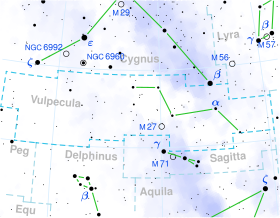HD 192685, also known as QR Vulpeculae or HR 7739, is a Be star about 1,000 ly away in the Vulpecula constellation. It is visible to the naked eye.
| Observation data Epoch J2000 Equinox J2000 | |
|---|---|
| Constellation | Vulpecula |
| Right ascension | 20h 15m 15.89542s[1] |
| Declination | 25° 35′ 31.0549″[1] |
| Apparent magnitude (V) | 4.60 - 4.80[2] |
| Characteristics | |
| Spectral type | B3V[3] |
| U−B color index | −0.73[4] |
| B−V color index | −0.18[4] |
| Variable type | γ Cas[2] |
| Astrometry | |
| Radial velocity (Rv) | −7.00[5] km/s |
| Proper motion (μ) | RA: +6.93[1] mas/yr Dec.: −3.89[1] mas/yr |
| Parallax (π) | 3.29 ± 0.51 mas[1] |
| Distance | approx. 1,000 ly (approx. 300 pc) |
| Absolute magnitude (MV) | −2.56[6] |
| Details | |
| Mass | 8.0[7] M☉ |
| Luminosity | 3331[6] L☉ |
| Surface gravity (log g) | 3.49[8] cgs |
| Temperature | 18,700[9] K |
| Metallicity [Fe/H] | −0.10[8] dex |
| Rotational velocity (v sin i) | 160[10] km/s |
| Other designations | |
| Database references | |
| SIMBAD | data |
Description edit
HD 192685 varies slightly in brightness and is classified as a γ Cassiopeiae variable.[2]
From October to December 1982 the Hydrogen alpha absorption line increased in emission strength by 30%.[11] The line is partially filled by redshifted emission.[13]
HD 192685 has excess infrared emissions (12-100 μm) which are interpreted to be free-free radiation in the gas surrounding the star.[14]
Companions edit
It has at least one companion with separation 0.55" and magnitude 7.55,[15] and may also be a long-period spectroscopic binary.[16]
References edit
- ^ a b c d e Van Leeuwen, F. (2007). "Validation of the new Hipparcos reduction". Astronomy and Astrophysics. 474 (2): 653–664. arXiv:0708.1752. Bibcode:2007A&A...474..653V. doi:10.1051/0004-6361:20078357. S2CID 18759600. Vizier catalog entry
- ^ a b c Samus, N. N.; Durlevich, O. V.; et al. (2009). "VizieR Online Data Catalog: General Catalogue of Variable Stars (Samus+ 2007-2013)". VizieR On-line Data Catalog: B/GCVS. Originally Published in: 2009yCat....102025S. 1. Bibcode:2009yCat....102025S.
- ^ Walker, G. A. H.; Yang, S.; Witt, A. N.; Fahlman, G. G. (Aug–Sep 1980). "The extinction of HD 200775 by dust in NGC 7023". Publications of the Astronomical Society of the Pacific. 92: 414. Bibcode:1980PASP...92..411W. doi:10.1086/130687.
- ^ a b Mermilliod, J. C. (2006). "VizieR Online Data Catalog: Homogeneous Means in the UBV System (Mermilliod 1991)". VizieR On-line Data Catalog: II/168. Originally Published in: Institut d'Astronomie. 2168. Bibcode:2006yCat.2168....0M.Vizier catalog entry
- ^ Gontcharov, G. A. (2006). "Pulkovo Compilation of Radial Velocities for 35 495 Hipparcos stars in a common system". Astronomy Letters. 32 (11): 759–771. arXiv:1606.08053. Bibcode:2006AstL...32..759G. doi:10.1134/S1063773706110065. S2CID 119231169.
- ^ a b Anderson, E.; Francis, Ch. (2012). "XHIP: An extended hipparcos compilation". Astronomy Letters. 38 (5): 331. arXiv:1108.4971. Bibcode:2012AstL...38..331A. doi:10.1134/S1063773712050015. S2CID 119257644. Vizier catalog entry
- ^ Tetzlaff, N.; Neuhäuser, R.; Hohle, M. M. (2011). "A catalogue of young runaway Hipparcos stars within 3 kpc from the Sun". Monthly Notices of the Royal Astronomical Society. 410 (1): 190–200. arXiv:1007.4883. Bibcode:2011MNRAS.410..190T. doi:10.1111/j.1365-2966.2010.17434.x. S2CID 118629873. Vizier catalog entry
- ^ a b Wu, Yue; Singh, H. P.; Prugniel, P.; Gupta, R.; Koleva, M. (2010). "Coudé-feed stellar spectral library – atmospheric parameters". Astronomy & Astrophysics. 525: A71. arXiv:1009.1491. Bibcode:2011A&A...525A..71W. doi:10.1051/0004-6361/201015014. S2CID 53480665.
- ^ Hohle, M.M.; Neuhäuser, R.; Schutz, B.F. (2010). "Masses and luminosities of O- and B-type stars and red supergiants". Astronomische Nachrichten. 331 (4): 349. arXiv:1003.2335. Bibcode:2010AN....331..349H. doi:10.1002/asna.200911355. S2CID 111387483. Vizier catalog entry
- ^ Abt, Helmut A.; Levato, Hugo; Grosso, Monica (2002). "Rotational Velocities of B Stars". The Astrophysical Journal. 573 (1): 359–365. Bibcode:2002ApJ...573..359A. doi:10.1086/340590.
- ^ a b Pavlovski, K.; Bozic, H.; Harmanec, P.; Horn, J.; Koubsky, P. (14 November 1983). "Sudden Brightening of the Recently Discovered Be Star HR 7739". Information Bulletin on Variable Stars. 2431 (1): 1. Bibcode:1983IBVS.2431....1P. ISSN 0374-0676.
- ^ Lefèvre, L.; Marchenko, S. V.; Moffat, A. F. J.; Acker, A. (November 2009). "A systematic study of variability among OB-stars based on HIPPARCOS photometry". Astronomy and Astrophysics. 507 (2): 1141–1201. Bibcode:2009A&A...507.1141L. doi:10.1051/0004-6361/200912304.
- ^ Green, Daniel W. E. (July 14, 1982). "2 Vul AND HR 7739". IAU Circular. 3710. IAU Central Bureau for Astronomical Telegrams. Retrieved 11 December 2012.
- ^ Cote, J. (July 1987). "B and A type stars with unexpectedly large colour excesses at IRAS wavelengths". Astronomy and Astrophysics. 181 (1): 83. Bibcode:1987A&A...181...77C. ISSN 0004-6361.
- ^ Eggleton, P. P.; Tokovinin, A. A. (2008). "A catalogue of multiplicity among bright stellar systems". Monthly Notices of the Royal Astronomical Society. 389 (2): 869. arXiv:0806.2878. Bibcode:2008MNRAS.389..869E. doi:10.1111/j.1365-2966.2008.13596.x. S2CID 14878976. Vizier catalog entry
- ^ Mason, Brian D.; Wycoff, Gary L.; Hartkopf, William I.; Douglass, Geoffrey G.; Worley, Charles E. (2001). "The 2001 US Naval Observatory Double Star CD-ROM. I. The Washington Double Star Catalog". The Astronomical Journal. 122 (6): 3466. Bibcode:2001AJ....122.3466M. doi:10.1086/323920. Vizier catalog entry
External links edit
- Robin Leadbeater (translation). "Processing the spectrum of the star HD192685". PROCESSING LHIRES SPECTRA.
- HD 192685 on WikiSky: DSS2, SDSS, GALEX, IRAS, Hydrogen α, X-Ray, Astrophoto, Sky Map, Articles and images
